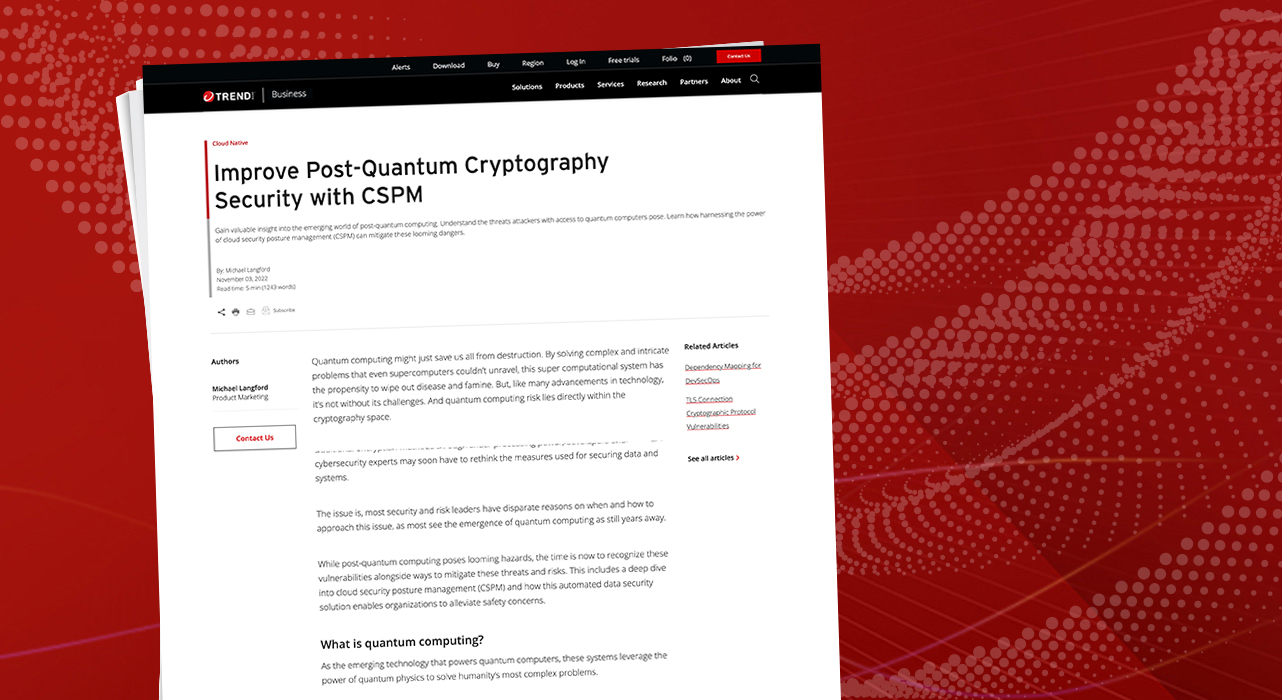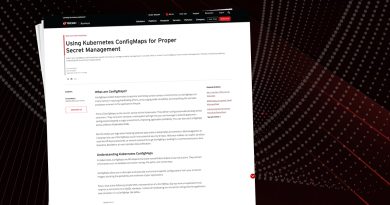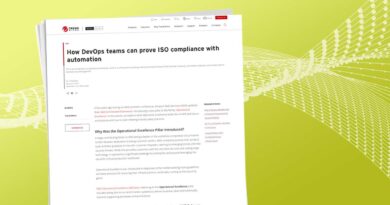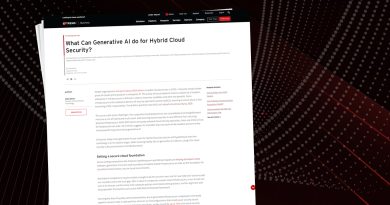Improve Post-Quantum Cryptography Security with CSPM


Quantum computing might just save us all from destruction. By solving complex and intricate problems that even supercomputers couldn’t unravel, this super computational system has the propensity to wipe out disease and famine. But, like many advancements in technology, it’s not without its challenges. And quantum computing risk lies directly within the cryptography space.
Cryptography provides security through various encryption and decryption techniques. This ensures the secure transaction of data and authentication of users for different organizational systems. With future quantum computers potentially compromising traditional encryption methods through sheer processing power, developers and cybersecurity experts may soon have to rethink the measures used for securing data and systems.
The issue is, most security and risk leaders have disparate reasons on when and how to approach this issue, as most see the emergence of quantum computing as still years away.
While post-quantum computing poses looming hazards, the time is now to recognize these vulnerabilities alongside ways to mitigate these threats and risks. This includes a deep dive into cloud security posture management (CSPM) and how this automated data security solution enables organizations to alleviate safety concerns.
What is quantum computing?
As the emerging technology that powers quantum computers, these systems leverage the power of quantum physics to solve humanity’s most complex problems.
This has led experts to look at how the ways we securely perform activities on the internet will be affected. Specifically, there has been concern about quantum computers’ ability to decrypt and break most public key encryptions (PKE), significantly compromising the confidentiality and integrity of systems running on the internet.
Luckily, a select number of security leaders and cyber risk managers have already started thinking of quantum-resistant solutions to avert this phenomenon.
What is post-quantum cryptography?
Also known as quantum encryption, post-quantum cryptography is the creation of cryptographic systems for classical computers, securing against threats from quantum computers. These systems should also be able to interoperate well with existing communication channels and protocols.
Post-quantum cryptography is a field that’s still developing. Existing PKE methods use the complexity of factoring, discrete logarithm problems, and the difficulty of calculating the elliptic curve discrete logarithm. It is just a matter of time before large-scale quantum computers can decipher the code these techniques produce. Post-quantum cryptography algorithms will ensure systems are resistant (using complex mathematical problems) to attackers, even those with access to a quantum computer.
To defend against the brute force of quantum computers, security leaders need to start thinking about post-quantum cryptography. It is important for organizations to decide whether to replace their traditional systems or supplement them with post-quantum cryptographic systems depending on available resources and costs.
What is Cloud security posture management?
Also known as CSPM, this set of security protocols aims to identify and remediate cloud misconfiguration problems and compliance monitoring risks. By checking the status of the cloud infrastructure as a service (IaaS) and platform as a service (PaaS) possible security gaps can be identified and remediated. CSPM tools examine a particular cloud environment and compare it to a set of best practices and known security risks and users are regularly alerted when a security risk is detected. More sophisticated CSPM tools can enable users to align their cloud configuration to compliance standards and correct problems automatically.
Enterprises at all stages of their digital transformation journey looking to expand their security risk management and visibility across hybrid, multi-cloud, and container environments that often employ these protocols, as CSPM allows for risk assessment and incident response.
Applying CSPM to mitigate risk
Cloud-based systems and services compose multiple interconnected resources that involve many moving parts. This complexity can make visibility in these environments a challenge, leading to misconfigurations—a control that contributes to up to 95% of all security breaches.
CSPM provides unified visibility into these environments, enhancing the security configuration of the cloud infrastructure’s assets. This gives users a single source of truth across different cloud environments, minimizing the likelihood of misconfiguration. CSPM features deliver timely detection and resolution by performing deep scans into the cloud infrastructure to discover hidden attack vectors and threats.
As quantum computing is still an emergent phenomenon, most methods for mitigating risk are still largely undiscovered. Despite cryptography being at the center of most business transactions worldwide, many CISOs and CIOs do not consider quantum computers an immediate threat. Part of the reason for this misconception can be attributed to executives’ lack of understanding the catastrophic dangers regarding compromised data, critical systems, resources (time to prepare, cost), or their underestimation towards the next steps required for quantum-safe preparation.
Initial work is taking place on new, more quantum-resistant certificates, algorithms, and other encryption technologies. For instance, the National Institute of Standards and Technology (NIST) has asked cryptographers and researchers for improvements to PKE algorithms in order to develop post-quantum cryptography solutions. This advancement will enable enterprises to guard against the encryption-break power brought on by quantum computing.
Because these quantum-proof algorithms and certificate development are still nascent, there is a need for more thorough compliance with regulations for organizations running their applications in the cloud.
By maintaining compliance measures and continuous real-time monitoring, CSPM can help keep security threats to significantly low levels. Real-time monitoring identifies potential perils and stays one step ahead of the new threats posed by quantum computing. This could include enforcing certain encryption levels or a standard on information in transit or at rest, proper management of encryption keys, or logging and event tracing.
Due to the broad and complex nature of cloud infrastructure, organizations often depend on manual security protocols to sustain compliance measures. This places automation at the center of a solid CSPM solution. Enterprises can use these capabilities to maintain compliance and implement a forward-thinking security posture to help defend against tomorrow’s threats. Automated CSPM solutions can detect and resolve compliance violations and internal security policies by better understanding the cloud environment. This is done through extensive assessment, evaluation, and testing. Automation gives decision-makers a clear understanding of their cloud security posture and helps recognize quantum computing risks.
In addition, CSPM solutions monitors cloud assets and operations to ensure they comply with security protocols and regulations. This monitoring makes it easier to identify threat vectors likely to affect the cloud environment, including future threats posed by quantum computing.
Next steps
Cryptography has several applications. However, enterprises primarily use it to ensure secure transactions and authenticate users in various systems. With its high computing power capabilities, quantum computing will make it possible to break into currently used algorithms making the data and messages these systems transmit vulnerable to attacks.
By integrating post-quantum computing, organizations can mitigate prevent an attack made by large-scale quantum computers by developing cryptographic algorithms. Most recently developed algorithms such as symmetric cryptographic algorithms, have proven to be relatively secure against the threat quantum computers pose.
Technology moves fast. Quantum computers are coming to a cloud environment near you. And it will happen sooner than you think.
Organizations need advanced solutions to combat the challenges that come with the quantum computing revolution. Luckily, CSPM provides sustainable visibility into the multi-cloud environments of an organization. This equips teams with a single source of truth to help reduce the risk of misconfiguring important cloud services. Automated CSPM solutions offer continuous monitoring and assessment of compliance policies, allowing threats to be easily identified.
While a new dawn of computing arrives, so does a new way of protecting your cloud security posture.
Read More HERE



